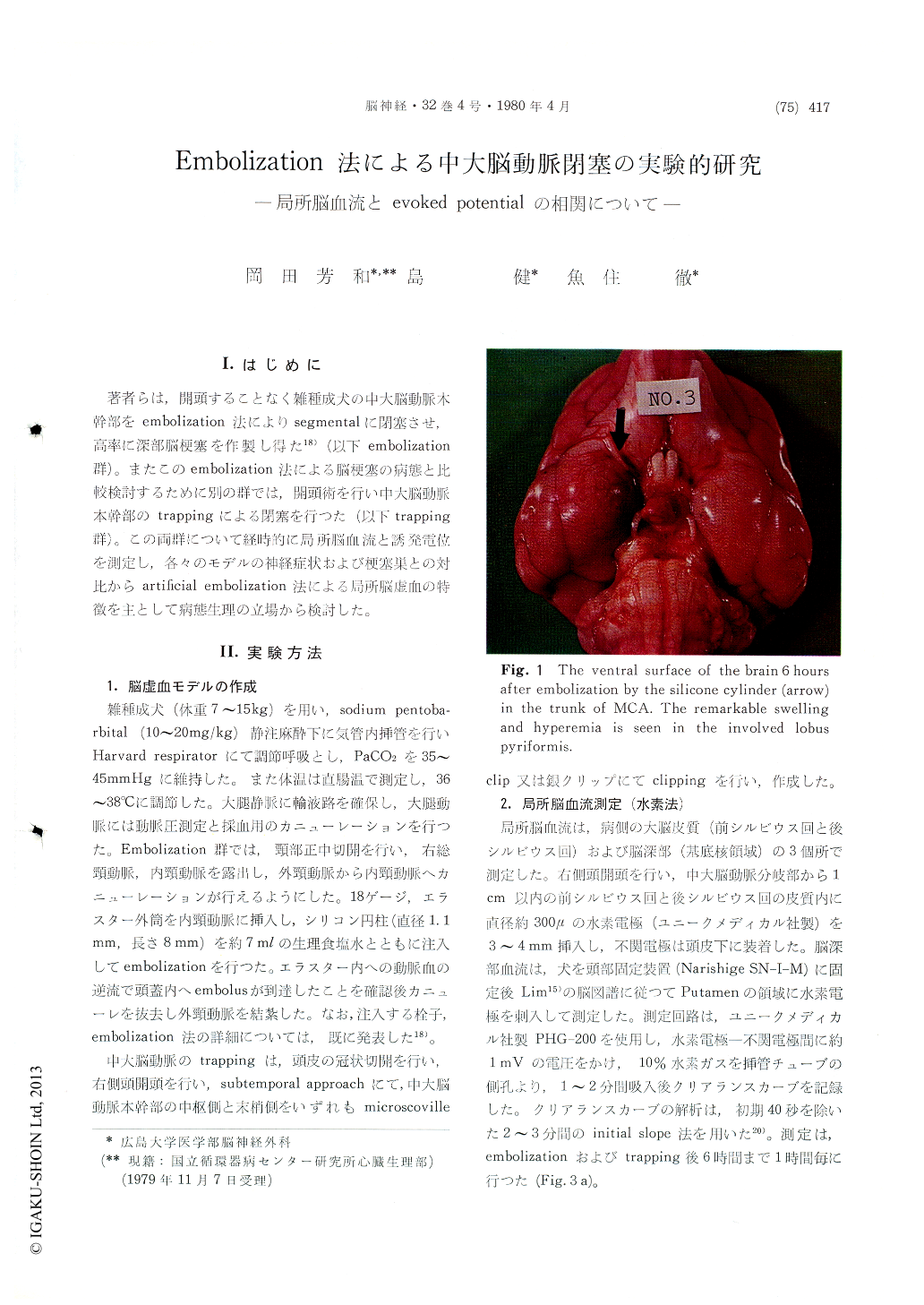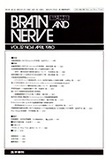Japanese
English
- 有料閲覧
- Abstract 文献概要
- 1ページ目 Look Inside
I.はじめに
著者らは,開頭することなく雑種成犬の中大脳動脈本幹部をembolization法によりsegmentalに閉塞させ,高率に深部脳梗塞を作製し得た18)(以下embolization群)。またこのembolization法による脳梗塞の病態と比較検討するために別の群では,開頭術を行い中大脳動脈木幹部のtrappingによる閉塞を行つた(以下trapping群)。この両群について経時的に局所脳血流と誘発電位を測定し,各々のモデルの神経症状および梗塞巣との対比からartificial embolization法による局所脳虚血の特徴を主として病態生理の立場から検討した。
This experiment was performed to study clini-copathophysiology of regional cerebral ischemia produced by embolization of the trunk of the middle cerebral artery (MCA) of dogs, in compari-son to that produced by trapping of the trunk of MCA.
Adult mongrel dogs were anesthetized by intra-venous injection of sodium pentobarbital (20-30mg/kg) and relaxed by pancronium bromide (0.1mg/kg). The artificial respiration was controlled to maintain normocapnia and normoxia.
A specially designed rubber cylinder was injected into the cervical internal carotid artery and a seg-mental occlusion of MCA was produced (emboliza-tion group). In a separate group MCA trunk was exposed by subtemporal approach and two scoville-clips ware applied to its proximal and distal sides (trapping group).
In both groups cerebral blood flow (rCBF) was measured in cortex of the anterior sylvian gyrus, posterior sylvian gyrus and basal ganglia on the affected side by the hydrogen clearance method. The epidural evoked potential on the occluded side was recorded in response to contralateral median nerve stimulation. The measurements of rCBF and evoked potential were repeated at intervals of an hour for six hours after MCA occlusion.
The animals of two groups were kept alive for 4 to 7 days and neurological deficits were evaluated after Smith's neurological evaluation score. After sacrificing the brain was removed and explored grossly and fixed in 10% formalin solution. Coronal sections of 5 mm in thickness were made and the infarct volume was calculated by the average end are method.
In the embolization group animals exhibited re-markable neurological deficits and the infarcts involved the lobus pyriformis, caudate nucleus and thalamus. Their neurological evaluation score was 2.7±0.34 (mean±SE) and their mean infarct vol-ume was 4.6±0.5cm3. The embolization of MCA trunk producd a remarkable decrease of rCBF in all measured regions. In basal ganglia rCBF de-creased most severely from the original value of 53.9±13.0(mean±SD) ml/100g/min to 21.5±8.9ml/100g/min at 6 hour after embolization. The amplitude of evoked potential decreased progres-sively from resting value of 100% to 53.0±7.6(mean±SE) % at 3 hour after embolization.
In the trapping group after recovery from anes-thesia all animals were able to walk but one ex-hibited forced circling movement. No infarction was found in any of them. In trapping group the decrease in rCBF was significantly less than inembolization group in all measured regions. And no significant changes were found in evoked po-tential amplitude over a period of 6 hours in trap-ping group.
As a result of this study the perforating arteries of the MCA seems to play an extremely important role in the development of deep cerebral infarction in dog. The decline of evoked potential amplitude and rCBF seems to be well corresponding to the degree of neurological deficits, infarct volume and infarct regions.

Copyright © 1980, Igaku-Shoin Ltd. All rights reserved.


